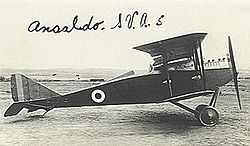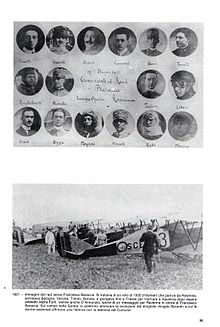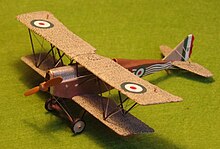Ansaldo SVA
| Ansaldo SVA | |
|---|---|
 SVA 5 SVA 5
|
|
| Type: | Reconnaissance plane , bomber |
| Design country: | |
| Manufacturer: | |
| First flight: |
March 3, 1917 |
| Commissioning: |
1918 |
| Production time: |
1918-1928 |
| Number of pieces: |
approx. 2000 |
The Ansaldo SVA was a family of Italian reconnaissance aircraft in biplane construction method during the First World War and in the later years.
History and construction
After the Italian warplanes , except for the heavy Caproni bombers, after Italy's late entry into the war - such as the types from Savoia-Pomilio - had proven to be unsuitable for the front, the Italian air corps had to make do with French types. In 1916, however, the designers Umberto Savoia , Rodolfo Verduzio and Celestino Rosatelli began work on the first Italian fighter type on a private initiative . Your idea won over the military authorities that set up the armaments company Gio. Ansaldo & Co. SA in Genoa -Borzoli with a branch in Turin was entrusted with the further development.
The structure of the SVA was connected by cross struts and therefore did not require any wire bracing. The aircraft fuselage, clad with plywood, had the pentagonal cross-section typical of Ansaldo. The wings were covered with canvas. The prototype was built by Ansaldo technicians in Borzoli Mare under the assistance of Lieutenant Giuseppe Brezzi, Technical Director. Soon afterwards, pre-series production in Borzoli and Bolzaneto began. On March 19, Sergeant Mario Stoppani started his first test flight in Grosseto; on further test flights, the machine reached a top speed of 223 km / h. Other experienced Italian fighter pilots continued the tests. Compared to the previously flown French types Hanriot HD.1 and SPAD S.VII , the SVA turned out to be too clumsy for aerial combat, but it proved to be robust and demonstrated excellent flight performance.
While the development of a fighter aircraft was instead advanced with the Ansaldo A.1 Balilla , the original intention of using the SVA as a fighter was dropped. In addition to the clumsiness, the position of the on-board weapon proved to be disadvantageous for air combat . This was mounted in such a way that, on the one hand, the pilot could only reach it by means of a lever if the load was jammed and, on the other hand, only allowed a lower rate of fire due to the synchronization with the propeller. Another disadvantage was the SVA's easily damaged fuel tank. Instead, they pursued their further use as a reconnaissance aircraft and bomber, the altitude and speed of which had to be inaccessible to Austrian interceptors and ground defense. The machine, equipped with two machine guns, two cameras and bomb holders, was considered the fastest fighter aircraft that was used during the war.
After further attempts with Lorraine-Dietrich and Isotta-Fraschini engines, the SVA4 with SPA six-cylinder in-line engine went into series production from October 1917.
commitment
On October 9, 1917, Lieutenant Natale Palli made his first assignment at the wheel of an SVA
In February 1918, six new strategic reconnaissance squadrons ( 1 ° -6 ° Sezione Ric./Bomb. ) Of the Italian air force were set up, equipped with SVA and placed under the command of the army high command for long-range operations. This was followed by the well-known 87ª Squadriglia La Serenissima , the 89ª Squadriglia, later the 56ª and 57ª Squadriglia, and finally the Squadriglia 111 and 116 deployed in Macedonia and Albania . These squadrons undertook extensive reconnaissance flights and bomb attacks in the depths of the enemy hinterland and were in Also involved in spectacular long-distance missions during the last months of the war:
- On February 28, 1918, four SVAs started in Ponte San Pietro , three of them loaded with 50 kg bombs each, the fourth with camera equipment for use against Innsbruck , 250 km away , where they attacked railway systems.
- On May 21, 1918, Arturo Ferrarin and Antonio Locatelli from the 87ª Squadriglia carried out a 700 km long-range reconnaissance mission during which they crossed the Alps and photographed the German Zeppelin base near Friedrichshafen on Lake Constance .
- In April Locatelli carried out another 900 km remote sensing flight to Zagreb .
- The 1000 km flight over Vienna of the 87ª Squadriglia from San Pelagio near Padua on August 9, 1918, which was carried out on the initiative of the Italian poet Gabriele d'Annunzio , caused a particular stir . D'Annunzio himself took a seat in a two-seater converted SVA10, which was piloted by the squadron leader Captain Palli. Out of 11 planes launched, 7 reached the Austrian capital, over which they circled for about twenty minutes, taking aerial photographs and dropping 50,000 propaganda leaflets written by D'Annunzio and Ugo Ojetti . During this flight, which led 80% over enemy territory almost unhindered by enemy defenses, only one machine was lost which had to make an emergency landing near Wiener Neustadt due to an engine failure .
- In September 1918 a prototype with a 250 HP Isotta Fraschini engine carried out a long-haul flight over 1,448 km.
Above all, the SVA intervened more and more in the course of the war on the Italian Alpine front and on the Adriatic coast . With their reconnaissance successes, they made a significant contribution to the defensive success against the failed Austro-Hungarian summer offensive and the victory of Vittorio-Veneto, which led to the collapse of the front and the ultimate defeat of the Central Powers in the Alpine region.
Post-war use

Around 1250 SVA had been built by the end of the war; they were therefore the second highest rank among the aircraft manufactured in Italy during the war. In 1923 they were flown by six squadrons in Italy and North Africa.
Production ran until 1928; about 2000 SVA of all types were delivered and served as military and sport aircraft until the 1930s. The last variant, an SVA with a 250 HP Isotta Fraschini engine, reached top speeds of 240 km / h.
Some aircraft also went to South America and proved themselves due to their excellent high-altitude flight characteristics; so the Peruvian lieutenant Alejandro Velasco Astete crossed the Andes on August 29, 1925 with his SVA from Campo de Las Palmas near Lima via Cuzco to Puno .
A flight adventure under the direction of Lieutenant Arturo Ferrarin, who took off with a total of 7 aircraft on February 26 for a long-distance flight from Rome to Japan , caused a particular stir . Two planes with Ferrarin and his comrade Masiero finally reached Tokyo on May 25, 1920 after 18,105 km and 109 hours of flight .
variants
The SVA4 that were initially produced was followed by the most built and almost identical Type 5 with a larger fuel tank and longer range. In spring, AER delivered the first SVA3s with shortened wings as interceptors for homeland security groups. The two-seater Type 10 appeared from August 1918. A few unarmed two-seater SVA9s also came to the front, they were mainly used for preliminary exploration and navigation of the SVA formations, but were mostly delivered to training units equipped with double steering. The Regia Marina had some machines converted into torpedo planes on a trial basis; She also received 50 SVA with swimmers for use over the Adriatic .
- SVA1 prototype
-
SVA2 - 65 series aircraft
- ISVA - float version (I = Idroplano - "seaplane")
-
SVA3 SVA.4 of - AER made
- SVA3 Ridotto - interceptor for defense against zeppelins
- SVA4 - remote reconnaissance aircraft with camera equipment, bomb device
- SVA5 - long-range reconnaissance aircraft with increased tank capacity
- SVA6 - only prototype (bomber)
- SVA8 - prototype only
- SVA9 - unarmed two-seat trainer aircraft with double controls
- SVA10 - two-seater, with a rigid Vickers machine gun for the pilot and a movable Lewis machine gun on a rotating ring mount for the observer. Some as SVA10 IF with 250 HP- Isotta Fraschini - or as SVA10 Lorraine with Lorraine-Dietrich engine. The machine used for the flight over Vienna was a variant of the SVA 10 and was also known as the Vienna type. In contrast to the normal SVA 10, the Vienna type had the pilot's seat at the rear, while a larger tank was installed under the front seat on which an emergency seat for a second flight attendant was mounted. Another variant of the Vienna type was the Berlin type . This had an additional fuel tank of about 50 liters under the pilot's seat. Whether this machine, designed for a flight over Berlin, was actually ever built cannot be clearly proven.
Technical specifications
| Parameter | SVA3 | SVA4 | SVA5 | SVA9 | SVA10 |
|---|---|---|---|---|---|
| Construction year | 1918 | ||||
| Intended use | Scouts, bombers | Trainer aircraft | Scouts, bombers | ||
| crew | 1 | 2 | |||
| length | 8.10 m | 8.15 m | |||
| span | 7.75 m | 8.80 m | 9.10 m | ||
| height | 2.60 m | 2.94 m | 2.92 m | ||
| Wing area | 22.02 m² | 26.93 m² | |||
| Empty mass | 667 kg | 701 kg | 667 kg | 692 kg | 730 kg |
| Takeoff mass | 891 kg | 975 kg | 989 kg | 1061 kg | |
| liquid-cooled six - cylinder in - line engine | SPA 6A, 195 kW (265 hp) | ||||
| Top speed | 226 km / h | 216 km / h | 237 km / h | 220 km / h | 211 km / h |
| Rate of climb | 5 m / s | ||||
| Climbing time to 1000 m | 2:40 min | ||||
| Climbing time to 2000 m | 6 min | ||||
| Ascent time to 3000 m | 11:30 min | 12 min | 8 min | 14 min | 11 min |
| Climbing time to 4000 m | 12:50 min | ||||
| Ascent time to 5000 m | 18 min | ||||
| Climbing time to 6000 m | 25 min | ||||
| Summit height | 7000 m | 6700 m | 5000 m | ||
| Range | |||||
| Flight time | 3 h | 3:15 h | 6 h | 4 h | 3–5 h |
| Armament | 2 machine guns, bombs, cameras | - | 2 machine guns, bombs, cameras | ||
Performance comparison with other types of aircraft in front service (autumn 1918)
| Surname | country | Engine power | Top speed | Takeoff mass | Armament | Summit height |
|---|---|---|---|---|---|---|
| Ansaldo SVA5 |
|
265 hp | 237 km / h | 975 kg | 2 and 90 kg bombs | 7000 m |
| Fokker D.VII |
|
180 hp | 189 km / h | 910 kg | 2 | 6000 m |
| Fokker D.VIIF |
|
226 hp | 205 km / h | 910 kg | 2 | 7000 m |
| Palatinate D.VIII |
|
160 hp | 190 km / h | 740 kg | 2 | 7500 m |
| Palatinate D.XII |
|
160 hp | 180 km / h | 902 kg | 2 | 5640 m |
| LFG Roland D.VIa |
|
160 hp | 190 km / h | 820 kg | 2 | 5500 m |
| Siemens-Schuckert D.IV |
|
160 hp | 190 km / h | 735 kg | 2 | 8000 m |
| Fokker D.VIII |
|
110 hp | 204 km / h | 605 kg | 2 | 6300 m |
| SPAD S.XIII |
|
220 hp | 222 km / h | 820 kg | 2 | 6650 m |
| Sopwith Snipe |
|
230 hp | 195 km / h | 955 kg | 2 | 6100 m |
| Sopwith Dolphin |
|
200 hp | 211 km / h | 890 kg | 2 | 6100 m |
| Sopwith Camel |
|
130 hp | 185 km / h | 659 kg | 2 and four 11.3 kg bombs | 5791 m |
| SE5a |
|
200 hp | 222 km / h | 880 kg | 2 | 5185 m |
Received aircraft
SVA5 in the Museo dell'aeronautica Gianni Caproni
Some planes are preserved in museums, mostly marked with the Venetian lion of St. Mark, the relay badge of the 87ª Squadriglia:
- SVA5 No 11777, flown by Lieutenant Gino Allegri during the flight over Vienna, Museo dell'aeronautica Gianni Caproni in Trient ,
- SVA5 No 11721 flown by Major Granzarolo Giordano Bruno during the flight over Vienna, Italian Aviation Museum Vigna di Valle .
- SVA5 No 24525, San Pelagio Aviation Museum
- SVA9 No 89 private property in Turin
- SVA10 No 12736, flown by Gabriele D'Annunzio and Captain Natale Palli on the flight over Vienna, Vittoriale degli italiani in Gardone Riviera
The following replicas will also be exhibited:
- SVA5 in Genoa Airport
- SVA5 in the Peruvian Air Force Museum in Lima
- SVA9 at the Japanese Air Force aircraft park in Hamamatsu
See also
literature
- Enzo Angelucci, Paolo Matricardi: The planes. From the beginning to the First World War . Falken-Verlag, Wiesbaden 1976, ISBN 3-8068-0391-9 , ( Falken manual in color ).
- Gianni Cattaneo: The SVA (Ansaldo) Scouts . Profile No. 61, Profile Publications Ltd., Leatherhead, Surrey
- Heinz Nowarra: The Development of Airplanes 1914–1918 . Lehmanns, Munich 1959.
- Kenneth Muson: Bombers, surveillance and reconnaissance aircraft 1914-1919 . Orell Füssli, Zurich 1968.
Web links
- [5] Description
- [6] Description (English)
- [7] Description (English)
- [8] Description (Russian)
- [9] Description (Russian)
- [10]
Individual evidence
- ↑ cf. [1]
- ↑ Luigino Caliaro: I raid della sezione 1ª SVA since Sovizzo in: Rivista Aeronautica n 6/2015 S. 98th
- ↑ http://www.incaland.com/MuseoFAP/ALEJANDR.htm
- ↑ cf. [2]
- ↑ Paolo Miana: Ansaldo SVA analisi di un successo in: Museo dell'Aeronautica Gianni Caproni (ed.): Gabriele D'Annunzio avviatore , Museo dell'aeronautica Gianni Caproni, Trient 2014 ISBN 978-88-96853-03-0 p. 87.
- ↑ [3]
- ↑ [4] homepages












